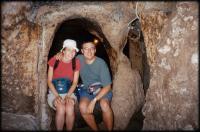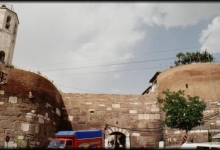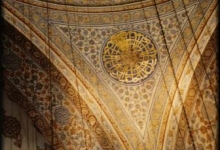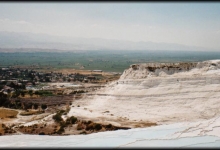Everything they needed to survive is found here. Ventilation shafts, kitchens, dining halls – the only thing we were wondering about was the restrooms. The two underground cities you can tour are apparently very similar. We satisfied ourselves with just seeing Kaymakli. To get there, we took a minibus to Neveshir, where we took a local bus to Kaymakli. It was pretty easy. When we got off the bus in Kaymakli, the driver refused to drive on until he saw we were walking in the right direction towards the underground city! These people are so incredibly nice. We had to cross the road, walk up a small street lined with souvenir shops and stalls (we knew we were getting close!) and hang a right at the end into the underground city.
Like in the open-air museum, getting around tour groups can be a bit of a hassle in the caves. I believe Kaymakli has the advantage here: It is less popular. Guides will try to sell you their services at the entrance. They are really not necessary. They will promise you you will get lost, you won’t understand what you’re seeing, etc etc. Whatever. It’s impossible to get lost, as the passages are all one-way with big arrows pointing up or down. You’d have to be blind. (ok so my epinion’s title isn’t quite true, but I just had to slip that in to my epinion’s content somewhere)










Who attacked agains who? Who were inviders? Who lived in these cities? When undeground cities were built up?
A lot of additional questions.
[Reply]
I have been to Anatolia about 3 years ago. It is even more unbelievable when you go and visit these underground cities.
I’m really amazed how people could dig that deep back in that time where there was no machine. Only man power, in that scale…
[Reply]
Hi Vahur,
The Romans were the threat to indigenous Christians who somehow built these places out of the rock. The same thing happened in Rome where you have the catacombs. These Christian communities were there pre-Constantine and they lived a very simple, traditional life-way in keeping with the customs of the people of Israel. They had no hierarchy or institutional organization – all of which came much later because of Constantine who thought it in the best interests of the empire to imperialize Christianity and take “the native” out of the Christian. This is why it is important to give voice back to original Christianity and for us indigenous peoples to re-claim what is ours and recover what has been taken from us and silenced by empire.
*:)
Siuyin.
[Reply]